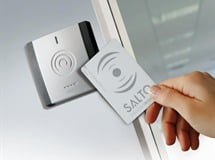IT’S a mistake to underestimate the power of SALTO’s access control solutions. At their heart, SALTO’S access control solutions are built around a range of battery-powered, wireless locking devices including electronic escutcheon locks, electronic mortise locks, oval cylinders, locker locks, mortise locks, half cylinders and plenty more.
These SALTO locks retrofit into existing mortise locks or knobsets in minutes and function using reader technologies including smart card, contactless smart card and dual technology cards, not expensive mechanical keys that must all be replaced if one is lost. The locks are designed to be installed in off-line applications on doors (or padlocks) and a full audit trail of events, as well as changes to access authorisations, are passed around the system network on-card as part of what Salto calls SVN (Salto Virtual Network).
What is SVN? Well, oddly enough, it’s the credentials themselves moving around the building in the hands of cardholders. It’s a very simple concept but when you’re schooled in a hardwired world of readers linked to smart door controllers; directly linked to centralized control modules, linked to software-powered workstations; it’s actually a bit hard to get your head around SALTO at first. The easiest way to understand SALTO SVN is to mentally pull the non-volatile memory containing user authorisations and audit trails out of traditional door controllers and slot it into every single every single card and reader in the system. There. That’s SALTO.
Whenever cards and locks and cards and hot-spots meet, as part of their wireless exchange, they exchange a complete update of authorisations and events going on across the network. Through the hotspots this information funnels back to SALTO’s Pro Access management software running on a central PC, which allows administrators to manage things like access time zones, view audit trails, as well as driving anti passback and relay management.
Pro Access can manage large numbers of door installations, and as most access related information is written on the credential, the management of the doors becomes, in cases, a management of the credential. By simply updating the badge, you can change most access related authorisations of the users, including adding/deleting doors, time zones, calendars, etc.
The other thing to understand about SALTO is that it’s not hard wired. Instead SALTO’S solution is designed to meet the challenges of bringing the huge numbers of mechanical door locks in large facilities into an access controlled environment with full audit trails and the ability to grant or deny access without gigantic star configs of door controllers and RS-485 being installed.
Smaller sites benefit, too. In the past, if you had a building with say, 35 standalone electronic locks installed in it, each lock had to be reprogrammed manually if a cardholder was being removed. Salto’s networked locks work in a different way, with local locks and readers working in concert with those hot-spot readers (SALTO WRM 9001s connected to the central controller via Ethernet) with the cards being the mechanism by which the readers and central controller exchange information.
Using these hot-spots, the remote readers are able to share information about events and access control privileges with the central controller and throughout the network, with every card in the hand of every cardholder being part of the system’s distributed architecture of online and offline memory. It’s a strangly simple and awesome way for an access system to communicate.
Salto installations are a bit more complicated than the traditional stand alone access control locks of yore but much less complicated than hardwired and they have strengths that make them vastly superior to standalone locks.
What you actually get with SALTO is full function access control of all interior doors at a fraction of the cost of hard wiring and, according to SALTO at a cost that’s only marginally more expensive than a quality commercial mechanical masterkey system.
Fact is, you get all the features of a hardwired access control system with SALTO including unlimited audit trail, dynamic access profile changes, calendar and shift control, intruder alarm, automated unlock/relock periods, automatic lost keycard cancellation, departmental operator management, ethernet connectivity of all online devices and the
ability to interface with other popular access control and BMS
systems.
Importantly, communications between carrier and electronic lock are encrypted and secure and SALTO locks can always be opened from the inside using a single action panic feature that works in conjunction with the relevant mortise lock.
SALTO locks, like the SALTO XS4, have high security protection via high resistance, hardened anti-drill plates to protect wiring and reader area. Additional protection provided by hardened axes and floating steel balls in the handle area. Other neat features include low battery power indication monitored through the SALTO Virtual Network (SVN), emergency opening via portable programming device (PPD), non volatile memory.
Features of SALTO access control include:
* Off-line or on-line door controllers depending on the model
* Managed by software
* Virtual Network capable through SALTO Virtual Network Technology
* User on card audit trailing capability
* All communications between reader and door controller and PC encrypted
* No additional control panels are required
* Alarm input
* Set up made with Portable Programming Devices (PPD) or via PC
* Update made with Portable Programming Device (PPD) or SVN
* Anti Pass Back mode available depending on the model
* Firmware upgradable by PPD or direct from PC to on-line units.
Click to Bookmark Post
Post Bookmarked
29.3
C
Sydney
24.8
C
Canberra
32
C
Darwin
20.7
C
Hobart
25.8
C
Perth
27.1
C
Brisbane
18.9
C
Auckland
14.7
C
Melbourne










